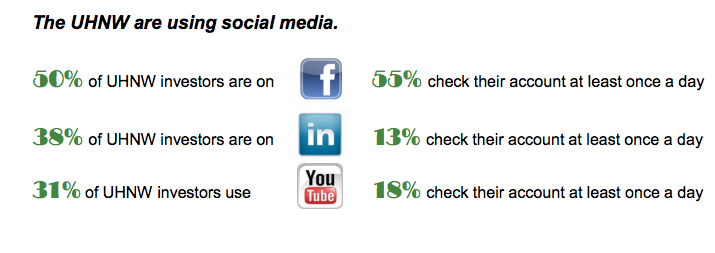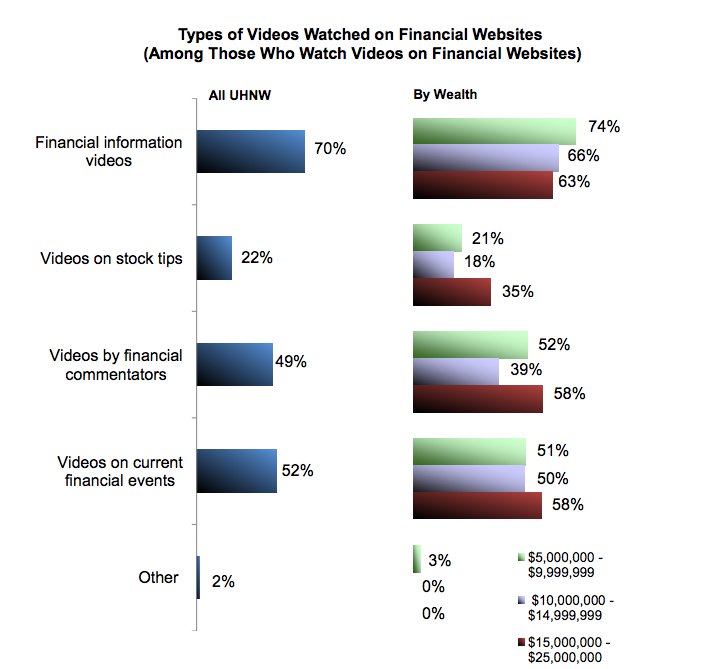Social media and mobile technology have become simple facts of life for the vast majority of Americans; wealthy clients are no different. They like Facebook and increasingly want to watch online financial videos. What they don’t seem to want to do is communicate with their advisors.
A recent survey by Spectrem Group of the social media and Internet habits of ultra high net worth individuals (defined as those with $5-$25 million in investable assets) casts light on how this exclusive and demanding group interacts with the digital realm. Overall, 70 percent of UHNW investors use some form of social media.

Much like among the rest of the wealthy population, the most popular social media platform for the UHNW is Facebook. Fifty percent of respondents have Facebook accounts, and among that number, 55 percent check the site at least once a day. Interestingly, the overall usage figures stay pretty even when broken down by age group, with only a 5 percent difference between the WWII generation, the most infrequent users (47 percent), and baby boomers, the most frequent (52 percent). However, less than 10 percent of respondents have communicated with their advisors via Facebook.
It’s important to note that for other popular platforms, there is a much starker divide in the numbers when it comes to age, with Gen X and millennial investors engaging far more actively than either boomers or the WWII generation. Indeed, according to the survey, age is the most consistent driving force behind technology use. For instance, while LinkedIn is the second most popular site, with 38 percent of respondents maintaining an account, that number skyrockets to 70 percent among the younger generations, though the average user only checks in once a week. Unfortunately, even among those youthful users, only 31 percent have interacted with their advisors on the site (it's in the low single digits for the other age groups).
Twitter presents an even larger chasm, as while only 11 percent of total UHNW individuals use the platform, 41 percent of Gen X and millennial respondents do. Still, users are more much likely to follow financial commentators (28 percent) than their own advisors (5 percent).
The figures surrounding YouTube are interesting in their own right. With 31 percent of respondents using the site, it’s the third most popular social network among UHNW individuals and is up 4 percent overall since this time last year. Its increasing popularity also underscores an interesting trend of UHNW investors developing a taste for online financial videos. Forty-two percent of UHNW investors watch videos on financial websites. In comparison, just over half of respondents read blogs on financial topics/news. At a glance, the offerings of most advisor websites don’t seem to reflect this demand for video content, skewing more heavily towards articles and blogs. Perhaps there’s a lack of understanding as to exactly what sort of topics this group would like to see addressed in videos.

Of those UHNW respondents who watch financial videos online, 70 percent watch general financial information videos, 52 percent watch videos on current financial events and 49 percent watch commentary by financial experts. Interestingly, only 22 percent watch videos to get stock tips. The wealthiest households surveyed are the most likely to consume the more specialized financial content (including, strangely, stock tips), while general financial information videos are more popular with less wealthy households.
Ultimately, though UHNW investors are increasingly using social media for information, it doesn’t appear that they really want to interact with their advisors on these platforms. Even among Gen X and millennial investors, consistently the most active users, direct contact with advisors remains fairly rare. The survey indicates that advisors are likely better off leveraging social media to establish reputations for themselves as experts in specific topics rather than using it to try and keep contact with current clients.
